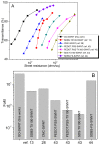Scalable Fabrication of High-Performance Transparent Conductors Using Graphene Oxide-Stabilized Single-Walled Carbon Nanotube Inks
- PMID: 29642446
- PMCID: PMC5923554
- DOI: 10.3390/nano8040224
Scalable Fabrication of High-Performance Transparent Conductors Using Graphene Oxide-Stabilized Single-Walled Carbon Nanotube Inks
Abstract
Recent development in liquid-phase processing of single-walled carbon nanotubes (SWNTs) has revealed rod-coating as a promising approach for large-scale production of SWNT-based transparent conductors. Of great importance in the ink formulation is the stabilizer having excellent dispersion stability, environmental friendly and tunable rheology in the liquid state, and also can be readily removed to enhance electrical conductivity and mechanical stability. Herein we demonstrate the promise of graphene oxide (GO) as a synergistic stabilizer for SWNTs in water. SWNTs dispersed in GO is formulated into inks with homogeneous nanotube distribution, good wetting and rheological properties, and compatible with industrial rod coating practice. Microwave treatment of rod-coated films can reduce GOs and enhance electro-optical performance. The resultant films offer a sheet resistance of ~80 Ω/sq at 86% transparency, along with good mechanical flexibility. Doping the films with nitric acid can further decrease the sheet resistance to ~25 Ω/sq. Comparing with the films fabricated from typical surfactant-based SWNT inks, our films offer superior adhesion as assessed by the Scotch tape test. This study provides new insight into the selection of suitable stabilizers for functional SWNT inks with strong potential for printed electronics.
Keywords: aqueous dispersion; carbon nanotube; electrical conductivity; graphene oxide; ink; mechanical flexibility; optical transmittance; rod coating.
Conflict of interest statement
The authors declare no conflict of interest.
Figures













References
-
- He L.X., Tjong S.C. Nanostructured transparent conductive films: Fabrication, characterization and applications. Mater. Sci. Eng. R Rep. 2016;109:1–101. doi: 10.1016/j.mser.2016.08.002. - DOI
LinkOut - more resources
Full Text Sources
Other Literature Sources

